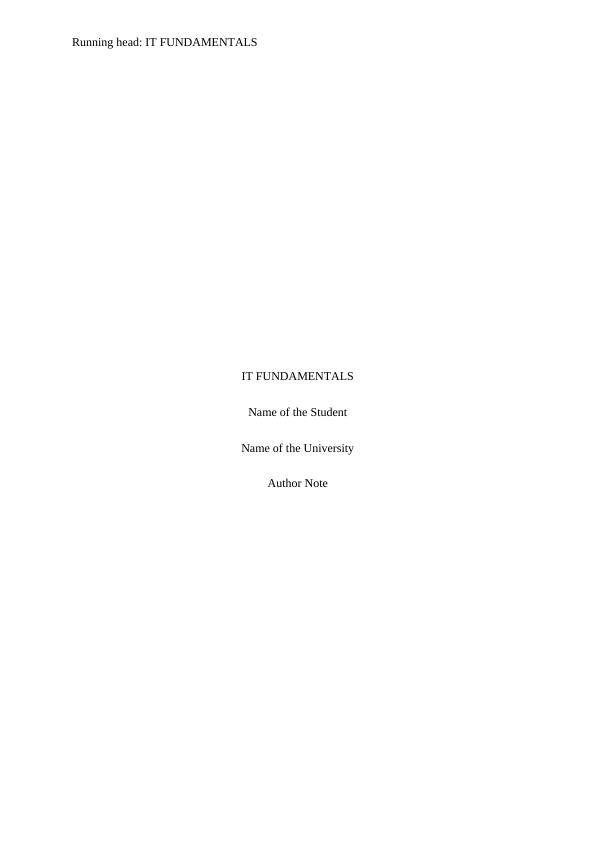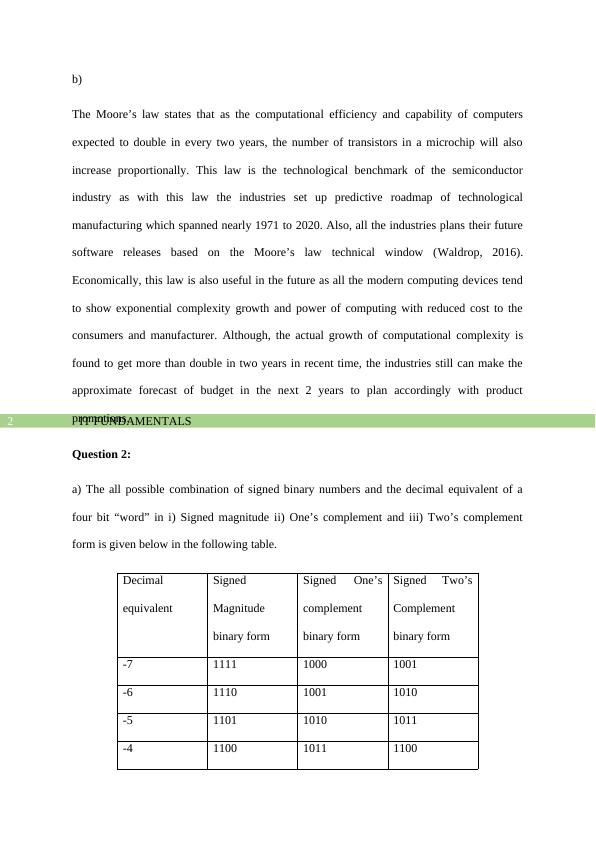IT Fundamental : Question and answer
Added on 2022-09-01
15 Pages1476 Words54 Views
Running head: IT FUNDAMENTALS
IT FUNDAMENTALS
Name of the Student
Name of the University
Author Note
IT FUNDAMENTALS
Name of the Student
Name of the University
Author Note

IT FUNDAMENTALS1
Question 1:
a) The basic architecture is almost same to all computers in the world which is a stored
program architecture invented John Von Neumann in 1945. The computer architecture where
the data and the instructions are stored in memory. In the design there exist one control unit
with a program counter and an instruction register which fetches data pieces from memory
and from the instruction set it is determined that if the input data is an instruction or just data.
Now, if the data is determined as instruction then that instruction is executed (Bao & Wang,
2017). For an example the instruction can be to add two pieces of data together. In that case
the two data pieces are fetched by the ALU and then a control signal is sent to the ALU and
then addition is performed by the registers and result is stored in another register.
STORED PROGRAM ARCHITECTURE
The stored program architecture is evolved in computer systems which is often called as
single bus system. Now, as the system becomes more practical from a physical constructional
point of view, the system is not allowed to fetch instructions and data at same instant (Harris
& Harris, 2019). This particular limitation is often called bottleneck of Von Neumann
architecture.
Question 1:
a) The basic architecture is almost same to all computers in the world which is a stored
program architecture invented John Von Neumann in 1945. The computer architecture where
the data and the instructions are stored in memory. In the design there exist one control unit
with a program counter and an instruction register which fetches data pieces from memory
and from the instruction set it is determined that if the input data is an instruction or just data.
Now, if the data is determined as instruction then that instruction is executed (Bao & Wang,
2017). For an example the instruction can be to add two pieces of data together. In that case
the two data pieces are fetched by the ALU and then a control signal is sent to the ALU and
then addition is performed by the registers and result is stored in another register.
STORED PROGRAM ARCHITECTURE
The stored program architecture is evolved in computer systems which is often called as
single bus system. Now, as the system becomes more practical from a physical constructional
point of view, the system is not allowed to fetch instructions and data at same instant (Harris
& Harris, 2019). This particular limitation is often called bottleneck of Von Neumann
architecture.

IT FUNDAMENTALS2
b)
The Moore’s law states that as the computational efficiency and capability of computers
expected to double in every two years, the number of transistors in a microchip will also
increase proportionally. This law is the technological benchmark of the semiconductor
industry as with this law the industries set up predictive roadmap of technological
manufacturing which spanned nearly 1971 to 2020. Also, all the industries plans their future
software releases based on the Moore’s law technical window (Waldrop, 2016).
Economically, this law is also useful in the future as all the modern computing devices tend
to show exponential complexity growth and power of computing with reduced cost to the
consumers and manufacturer. Although, the actual growth of computational complexity is
found to get more than double in two years in recent time, the industries still can make the
approximate forecast of budget in the next 2 years to plan accordingly with product
promotions.
Question 2:
a) The all possible combination of signed binary numbers and the decimal equivalent of a
four bit “word” in i) Signed magnitude ii) One’s complement and iii) Two’s complement
form is given below in the following table.
Decimal
equivalent
Signed
Magnitude
binary form
Signed One’s
complement
binary form
Signed Two’s
Complement
binary form
-7 1111 1000 1001
-6 1110 1001 1010
-5 1101 1010 1011
-4 1100 1011 1100
b)
The Moore’s law states that as the computational efficiency and capability of computers
expected to double in every two years, the number of transistors in a microchip will also
increase proportionally. This law is the technological benchmark of the semiconductor
industry as with this law the industries set up predictive roadmap of technological
manufacturing which spanned nearly 1971 to 2020. Also, all the industries plans their future
software releases based on the Moore’s law technical window (Waldrop, 2016).
Economically, this law is also useful in the future as all the modern computing devices tend
to show exponential complexity growth and power of computing with reduced cost to the
consumers and manufacturer. Although, the actual growth of computational complexity is
found to get more than double in two years in recent time, the industries still can make the
approximate forecast of budget in the next 2 years to plan accordingly with product
promotions.
Question 2:
a) The all possible combination of signed binary numbers and the decimal equivalent of a
four bit “word” in i) Signed magnitude ii) One’s complement and iii) Two’s complement
form is given below in the following table.
Decimal
equivalent
Signed
Magnitude
binary form
Signed One’s
complement
binary form
Signed Two’s
Complement
binary form
-7 1111 1000 1001
-6 1110 1001 1010
-5 1101 1010 1011
-4 1100 1011 1100

IT FUNDAMENTALS3
-3 1011 1100 1101
-2 1010 1101 1110
-1 1001 1110 1111
+0 0000 0000 -
-0 1000 1111 0000
1 0001 0001 0001
2 0010 0010 0010
3 0011 0011 0011
4 0100 0100 0100
5 0101 0101 0101
6 0110 0110 0110
7 0111 0111 0111
The first bit is the signed bit and the rest three bits are the magnitude of the number. Sign bit
is 1 when number is negative and it is zero when the number is negative in the signed
magnitude form. In one’s complement form one’s complement is performed on the
magnitude bits when the number is negative. In 2’s complement form the positive numbers
are same as signed bit form and negative number is the 2’s completed of its positive
equivalent (i.e. one’s complement plus one).
b)
From the above results it can be seen that with 4 bits the range of numbers that can be
represented is 15 from -7 to 7. Now, 15 = ( 24 – 1 ). Hence, with x bits of number the range of
numbers that can be represented in signed magnitude, One’s complement and two’s
complement form is ( 2x – 1 ).
-3 1011 1100 1101
-2 1010 1101 1110
-1 1001 1110 1111
+0 0000 0000 -
-0 1000 1111 0000
1 0001 0001 0001
2 0010 0010 0010
3 0011 0011 0011
4 0100 0100 0100
5 0101 0101 0101
6 0110 0110 0110
7 0111 0111 0111
The first bit is the signed bit and the rest three bits are the magnitude of the number. Sign bit
is 1 when number is negative and it is zero when the number is negative in the signed
magnitude form. In one’s complement form one’s complement is performed on the
magnitude bits when the number is negative. In 2’s complement form the positive numbers
are same as signed bit form and negative number is the 2’s completed of its positive
equivalent (i.e. one’s complement plus one).
b)
From the above results it can be seen that with 4 bits the range of numbers that can be
represented is 15 from -7 to 7. Now, 15 = ( 24 – 1 ). Hence, with x bits of number the range of
numbers that can be represented in signed magnitude, One’s complement and two’s
complement form is ( 2x – 1 ).

End of preview
Want to access all the pages? Upload your documents or become a member.
Related Documents
bonus assignment.lg...
|2
|448
|166
Module 5 S19 - Memory Managementlg...
|3
|699
|96
Computer Architecture Study Material with Solved Assignmentslg...
|9
|1428
|190
Frequency Modulationlg...
|19
|1193
|110
Computer System And Von Neumann Architecturelg...
|12
|1446
|14
Computer Organizations and Design - Solved Problems and Illustrationslg...
|14
|1990
|116
